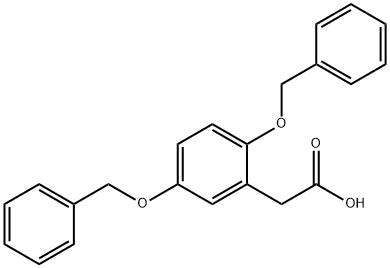HOMOGENTISIC ACID
Synonym(s):2,5-Dihydroxyphenylacetic acid
- CAS NO.:451-13-8
- Empirical Formula: C8H8O4
- Molecular Weight: 168.15
- MDL number: MFCD00004324
- EINECS: 207-192-7
- SAFETY DATA SHEET (SDS)
- Update Date: 2024-12-18 14:08:52

What is HOMOGENTISIC ACID?
Chemical properties
off-white to tan crystals or crystalline powder
The Uses of HOMOGENTISIC ACID
Homogentisic acid may be used as an analytical reference standard for the quantification of the analyte in the following:
- Urine matrices using reversed-phase liquid chromatography tandem mass spectrometry (LC-MS/MS).
- Strawberry tree honey samples using reversed phase-high performance liquid chromatography (RP-HPLC) and ion chromatography (IC).
It may also be used as an internal standard for the determination of ascorbic acid (AA) and uric acid (UA) in human plasma samples using high-pressure liquid chromatography–electrochemical detection (HPLC–ECD).
The Uses of HOMOGENTISIC ACID
An intermediate in the metabolism of tyrosine and phenylalanine. Occurs in plants and in the urine of alkaptonurics.
What are the applications of Application
Homogentisic Acid is an intermediate in the metabolism of tyrosine and phenylalanine
Definition
ChEBI: Homogentisic acid is a dihydroxyphenylacetic acid having the two hydroxy substituents at the 2- and 5-positions. It has a role as a human metabolite and a plant metabolite. It is a dihydroxyphenylacetic acid and a member of hydroquinones. It is functionally related to a phenylacetic acid. It is a conjugate acid of a homogentisate.
General Description
Homogentisic acid (HGA) is an intermediate formed during the catabolism of phenylalanine and tyrosine. Alkaptonuria, a metabolic disorder, is characterized by high levels of HGA in serum and urine due to the deficiency of the enzyme homogentisic acid oxidase, which is involved in the degradation of HGA.
Purification Methods
Crystallise homogentisic acid from EtOH/CHCl3 or H2O (solubility is 85% at 25o). [Beilstein 10 IV 1506.]
Properties of HOMOGENTISIC ACID
| Melting point: | 150-152 °C (lit.) |
| Boiling point: | 257.07°C (rough estimate) |
| Density | 1.3037 (rough estimate) |
| refractive index | 1.5090 (estimate) |
| storage temp. | 2-8°C |
| solubility | Soluble in methanol. |
| form | crystalline |
| pka | 4.4(at 25℃) |
| color | off-white to tan |
| Water Solubility | very faint turbidity |
| Merck | 14,4737 |
| BRN | 2692860 |
| CAS DataBase Reference | 451-13-8(CAS DataBase Reference) |
| EPA Substance Registry System | Benzeneacetic acid, 2,5-dihydroxy- (451-13-8) |
Safety information for HOMOGENTISIC ACID
| Signal word | Warning |
| Pictogram(s) |
 Exclamation Mark Irritant GHS07 |
| GHS Hazard Statements |
H315:Skin corrosion/irritation H319:Serious eye damage/eye irritation H335:Specific target organ toxicity, single exposure;Respiratory tract irritation |
| Precautionary Statement Codes |
P261:Avoid breathing dust/fume/gas/mist/vapours/spray. P264:Wash hands thoroughly after handling. P264:Wash skin thouroughly after handling. P280:Wear protective gloves/protective clothing/eye protection/face protection. P304+P340:IF INHALED: Remove victim to fresh air and Keep at rest in a position comfortable for breathing. P305+P351+P338:IF IN EYES: Rinse cautiously with water for several minutes. Remove contact lenses, if present and easy to do. Continuerinsing. P405:Store locked up. |
Computed Descriptors for HOMOGENTISIC ACID
HOMOGENTISIC ACID manufacturer
BASR Fine Chemicals Pvt. Ltd.
New Products
Tert-butyl bis(2-chloroethyl)carbamate (S)-3-Aminobutanenitrile hydrochloride N-Boc-D-alaninol N-BOC-D/L-ALANINOL 3-(2,4-Dimethoxybenzyl)dihydropyrimidine-2,4(1H,3H)-dione 7-Bromo-1H-indazole N-octanoyl benzotriazole 3,4-Dibenzyloxybenzaldehyde 4-Hydrazinobenzoic acid Electrolytic Iron Powder Fmoc-Val-Cit-PAB 1,1’-CARBONYLDIIMIDAZOLE R-2-BENZYLOXY PROPIONIC ACID 4-HYDROXY BENZYL ALCOHOL 1,1’-CARBONYLDI (1,2-4 TRIAZOLE) S-2-CHLORO PROPIONIC ACID (2-Hydroxyphenyl)acetonitrile 4-Bromopyrazole 5-BROMO-2CYANO PYRIDINE 5,6-Dimethoxyindanone 5-broMo-2-chloro-N-cyclopentylpyriMidin-4-aMine 1-(4-Methylphenylsulfonyl)-1H-1,2,3-benzotriazole 1-(2-Chlorobenzyl)-4-nitro-1H-pyrazole 1-(2-Nitrophenyl)-4-phenylpiperazineRelated products of tetrahydrofuran




![(R)-(2,5-DIMETHOXY-PHENYL)-[(9H-FLUOREN-9-YLMETHOXYCARBONYLAMINO)]-ACETIC ACID](https://img.chemicalbook.in/StructureFile/ChemBookStructure8/GIF/CB8494724.gif)



You may like
-
 (2,5-Dihydroxyphenyl)acetic acid 451-13-8 98%View Details
(2,5-Dihydroxyphenyl)acetic acid 451-13-8 98%View Details
451-13-8 -
 Homogentisic Acid 97% (GC) CAS 451-13-8View Details
Homogentisic Acid 97% (GC) CAS 451-13-8View Details
451-13-8 -
 Homogentisic acid 97% CAS 451-13-8View Details
Homogentisic acid 97% CAS 451-13-8View Details
451-13-8 -
 Homogentisic Acid CAS 451-13-8View Details
Homogentisic Acid CAS 451-13-8View Details
451-13-8 -
 Homogentisic acid CAS 451-13-8View Details
Homogentisic acid CAS 451-13-8View Details
451-13-8 -
 1446013-08-6 Fmoc-His-Aib-OH TFA 98%View Details
1446013-08-6 Fmoc-His-Aib-OH TFA 98%View Details
1446013-08-6 -
 2-ETHYLPYRIDINE 100-71-0 99%View Details
2-ETHYLPYRIDINE 100-71-0 99%View Details
100-71-0 -
 13162-05-5 99%View Details
13162-05-5 99%View Details
13162-05-5